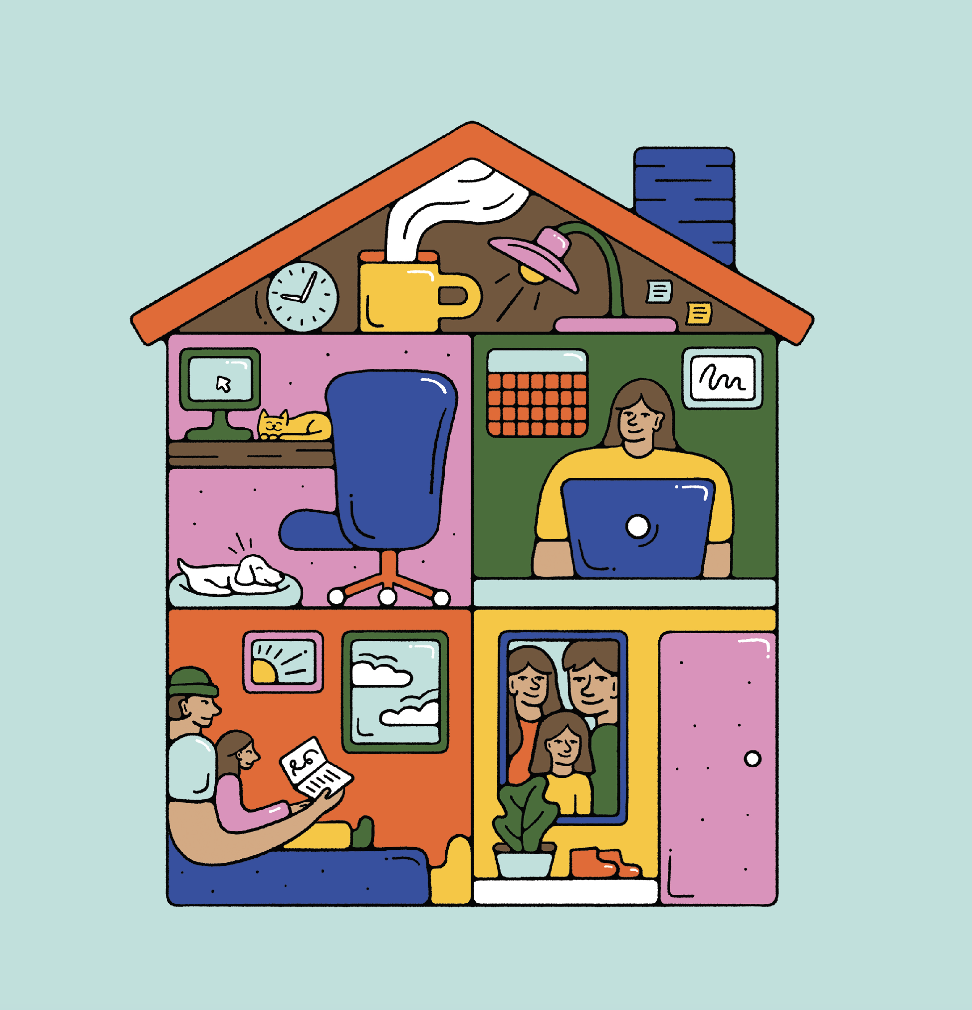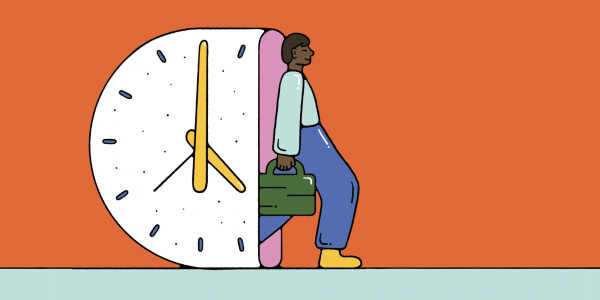Welcome to the post-pandemic, work-from-home revolution. Changing policies, technologies, and economic conditions over the past few years have brought about radical shifts in how, when, and where people work.
The once-in-a-generation experience of COVID-19 shined a light on existing workplace trends and, in many cases, led to new ones. Faculty members across Arts & Sciences have been at the forefront of groundbreaking research on the future of work. Three of those researchers — spanning the fields of political science, sociology, and economics — took us inside their recent findings.
Leveraging Leave
Margit Tavits measures how increasing paternity leave can decrease gender bias.

A change to Estonia’s parental leave policy offered Margit Tavits a unique opportunity to study how expanding leave for fathers can reduce sexist mindsets.
“Gender norms and biases are hard to overcome because they are so deeply ingrained in our society,” Tavits said. The Dr. William Taussig Professor in Arts & Sciences previously studied the origins and effects of sexist attitudes, including a 2023 paper that traced sexism in Europe back to the Middle Ages and revealed that biases persist over centuries.
Tavits, who has deep ties to Estonia, said the July 2020 policy change offered a rare chance to study parental leave policies in real time. Estonia had previously offered generous paid leave exclusively for mothers — 20 weeks — compared to a meager 10 days for fathers. After the change, fathers were entitled to 30 days, triple the previous amount.

“Extending caregiver leave for fathers has the power to decrease gender biases because it disrupts traditional gender roles and promotes less stereotypical ones,” she said.
Tavits worked with researchers from the United States, the United Kingdom, and Switzerland to conduct two surveys to measure gender bias before and after the policy change. The first surveyed roughly 1,300 new parents — both mothers and fathers — who were directly impacted by the policy change. The second targeted the public.
The surveys gauged Estonians’ support for gender equality, including pro-female policies and interventions. Respondents were asked if they agreed or disagreed with statements like “A preschool child is likely to suffer if his or her mother works” and “Men make better political leaders than women do.”
The surveys showed that new and expecting parents who could benefit from Estonia’s updated paternity leave policy were significantly more likely to express support for social and economic gender equality than those who had children before the change took effect.
When it came to the public, however, the researchers found that indirect exposure to policy reform didn’t do much to change people’s mindsets.
Tavits said her research offers a path for changing deeply ingrained sexist attitudes. “A lot of prejudice and bias has been tied to these very rigid, traditional gender roles,” she said. When deciding whether to extend parental leave to fathers, governments often focus on immediate outcomes such as childbearing decisions, labor market participation, and earnings, Tavits explained. This new research looks at the downstream consequences of these reforms on sexist beliefs. “It’s not just about equalizing distribution of labor at home, but also about changing how mothers and fathers look at the world.” — Jenny Bird and Sara Savat
The Cost of Caregiving
Caitlyn Collins studies the effects of the pandemic on working moms.

When the pandemic began, some believed there might be a silver lining for working mothers.
“People thought working from home could allow fathers to see how much work goes into managing the domestic sphere and we might see an equalization in the work moms and dads do in different-sex couples to manage the household,” said Caitlyn Collins, associate professor of sociology. “But that didn’t happen.”
In fact, Collins and co-authors Liana Christin Landivar of the Maryland Population Research Center, Leah Ruppanner of the University of Melbourne, and William Scarborough of the University of North Texas found the opposite to be true.
Their study, published four months into the pandemic, showed that COVID-19 lockdowns worsened the gender gap in work hours: Women did more caregiving and worked fewer hours than men.
The researchers looked at changes in married mothers’ and fathers’ work hours between February and April 2020 — a window that captured the month preceding the widespread outbreak of COVID-19 in the United States through its first peak. They found mothers with young children reduced their work hours four to five times more than fathers. If that trend continued after the pandemic, it could have a lasting impact on gender equity in the workplace, the researchers wrote: “Future merit-based opportunities and pay rises may disproportionately benefit men whose work commitments remained high during the pandemic.”
Collins and her collaborators published several other papers on families, employment, and childcare in the pandemic era, including one that revealed that increased access to Head Start programs during the Great Recession kept many families from falling into poverty and helped others escape it. The researchers suggest that increased federal funding for Head Start is needed to support families dealing with the long-term fallout of the pandemic. Another paper showed how the delayed reopening of in-person school had more serious career consequences for women than men, especially less-advantaged women.

This research is part of Collins’ career-long interest in gender inequality. For her 2019 book “Making Motherhood Work: How Women Manage Careers and Caregiving,” she interviewed hundreds of middle-class working mothers in the U.S. and Europe to learn how they navigated career and family. In their conversations, all of the women echoed the importance of childcare, a resource so vital to maternal and family success that Collins said she feels a “moral obligation” to focus on it in her work.
So, while her 2020 paper showed that the pandemic exacerbated existing caregiving trends, Collins said there was, in fact, a silver lining — just not the one some predicted.
“I’m heartened about what flexible and remote work has done for working mothers and workers in general,” Collins said. She called the pandemic, which pushed many employers to allow telecommuting, a revolutionary event that may ultimately offer an upside for working moms who have long wanted more flexible working arrangements. Collins, Landivar, Ruppanner, and Scarborough’s latest paper found that access to telecommuting was an important resource to help sustain mothers’ employment during the pandemic, though it had little impact on working fathers.
Still, Collins is quick to point out that telecommuting isn’t a perfect solution. Remote work was largely adopted by companies with white-collar workers, excluding many hourly and low-income employees who need flexibility on the job. But, overall, she said, this is a step in the right direction. “The flexibility of telecommuting opens up possibilities for mothers and may lead to increased freedom for workers overall.” — Jenny Bird
Missing Men
Yongseok Shin discovers intriguing gender-related trends in the latest U.S. recession.

Economic recessions normally occur when the number of people in the workforce falls. In the wake of the COVID-19 pandemic, however, Yongseok Shin, the Douglass C. North Distinguished Professor in Economics, found something different at play.
Two years after the disease emerged, the number of workers had returned to roughly what it was prior to COVID-19 lockdowns, but recovery still lagged. For the first time in history, the recession wasn’t fueled by fewer workers but, rather, by a drop in the number of hours people worked.
The leaders of this trend? Highly paid, college-educated men.
With a tight job market and educated workers in demand, Shin said it’s likely this group felt secure enough to cut back on their hours and seek new work-life balance, a trend the media coined “quiet quitting.”
“This is a positive development,” Shin said. “If everybody is working lots of unpaid overtime, you don’t want to be the only one not doing that. But if others are working less, then you can take your foot off the gas pedal.”
Remote work likely contributed to this trend as well, Shin hypothesized, helping workers cut back on hours without losing productivity.
Meanwhile, young men without college degrees have been the slowest group to return to the workforce, Shin said. This trend started long before the pandemic, an escalation of a phenomenon first seen in 2007. During the Great Recession, an increasing number of young, less-educated men began choosing to sit out of the labor market altogether. The pandemic only intensified the shift, he said. Shin worries this could have a significant impact on future earnings and opportunities for this demographic.

“People who aren’t firmly attached to the labor market when they’re young tend not to have stable careers or strong earnings growth as they age,” he said. “To the extent that they are not fully aware of such long-term consequences, it may come with a high personal and social cost.”
Shin said that while many studies done early in the pandemic (like the one led by Collins) found that women were disproportionately impacted, his research shows a reversal of this trend. “In the depths of 2020, the pandemic proved to be harsher to women and their participation in the workforce suffered more than men,” Shin explained. “But it also recovered more quickly.”
His data show that by 2021, it was women, not men, who reentered the workforce the most. Shin attributes this to the rise of remote work and the flexibility that comes along with it. “Though women workers might not have all the childcare they would want due to worker shortages, opportunities stemming from technology and telecommuting have allowed them to cope — somehow they are making it work.”
Shin and his coauthors, WashU PhD candidates Dain Lee and Jinhyeok Park, concluded that researchers and policymakers monitoring recessions should consider the number of hours people are working as well as the number of workers participating in the market. And while Shin and his colleagues have guesses about why older men were working fewer hours and younger men were opting out, they know there is more research to be done: “These important topics are left for future research.” — Jenny Bird




